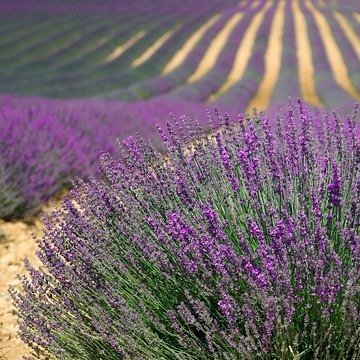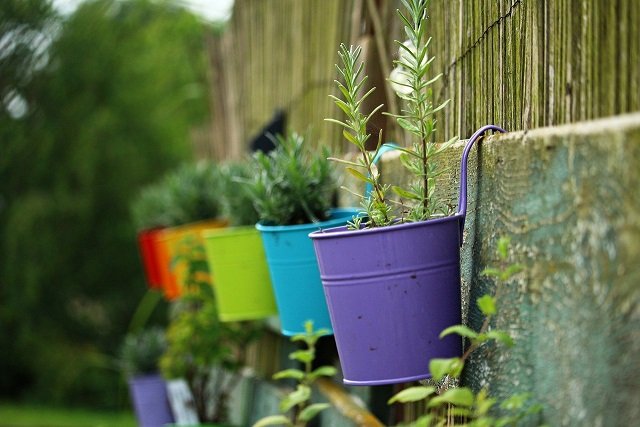Trying to grow lavender in pots? If so, you will have to try your best to mimic the same soil as its native dwelling, the Mediterranean.
The best soil mix for potted lavender usually contains 30%-50% sand/gravel and 70%-50% regular soil. Its pH should be neutral or alkaline (pH 6.5-8).
The mix should not absorb and hold too much water.
Factors to consider for the best soil mix for potted lavender
Let us look at the factors in detail.
1. Soil Requirements For Potted Lavender
Soil is a sensitive topic when it comes to lavender. These plants will pick up and react to any slight change in their surrounding soil.
Severe changes in the soil will affect the plants and correcting the problem is required to save your plants.
Here are some of the soil conditions lavender requires to grow and flower at its best:
- Porous soil with good drainage
- Neutral or slightly alkaline pH levels
- Low to medium concentration of nutrients
- No added fertilizer or compost
Failure to provide these will lead to lavender wilting or discoloration of the foliage.
2. Water Drainage Capacity
If you observe lavender in its native area (the Mediterranean) you’ll notice something unique about the soil. The soil is extremely loose as its major constituent is sand with rock fragments.
Although it seems impossible for plants to grow in this soil, it’s this type of soil in which lavender thrives.
Soils such as these drain well because there are more spaces between the particles than most other soils. Plus the sand and rock particles do not absorb water and instead let it pass through easily.
Lavender doesn’t do well in moist soils as the roots become wet and saturated with water. When the roots are surrounded by wet soil for too long, they can develop a condition known as root rot.
Wet soil can even invite infection by harboring fungal spores.
For growing lavender, soils with the least tendency to absorb and hold water are the most suitable. This automatically eliminates soils that contain bark chips and compost matter that holds water.
Ideally, the soil should drain enough to let the soil dry between two watering sessions.
3. pH Levels
It is not just the appearance and texture that lavender plants are specific about. Chemical features will also play a part in dictating the growth course of your lavender.
It is important to determine and test the soil prior to planting.
A simple test kit will calculate the pH levels of your soil. Garden soil can be acidic by nature. If organic material is present, the gradual breaking down process can convert the soil to a neutral pH level.
This might not be the best result for lavender but it is acceptable and will not create any negative effects!
The best pH range for a potting mix to support lavender plants is pH 6.5 to 8. This means a neutral to alkaline soil pH is best for lavender. These plants will not tolerate soil with acidic pH!
So what happens if your garden has acidic soil? Planting your lavender in this soil will cause growth issues as acidic soils don’t treat the plants well.
Thankfully, you can still grow lavender in pots after this acidic soil is corrected.
To make sure your soil has the right pH for potted lavender, you can amend it. Increase soil pH levels for lavender by adding limestone (or some form of lime) or wood ash.
Be warned that increasing soil pH takes time and should be done in advance to avoid delays during planting.
4. Nutrient Content
Those soils which have an increasing percentage of compost or plant waste matter tend to be very rich in nutrients. But, this is exactly what you will want to avoid giving to your plants. Lavender is not a high-feeding plant.
Grow your lavender in soils with low to medium nutrient levels to get the best results. Choosing rich soil will result in leggy growth of the plant but few or no flowers will be produced!
Providing your lavender with poor soil (low/medium nutrient concentration) enhances the chances of getting more flowers and a better aroma.
Fertilizing your lavender is not necessary since this provides more nutrients, leading to leggy overgrowth of foliage.
Avoid providing your plants with any form of extra nutrients, this includes liquid fertilizer, powder fertilizer, or even solid fertilizer.

What Is The Best Soil Mix for Potted Lavender?
As you can see, lavender is a fussy plant that wants what it wants when its soil is in question. Defying your lavender’s demands will lead to poor growth, flowering, and oil production.
To bypass both you and your plants from suffering, making your own soil mix is the best solution.
We’ll tell you what to look for when making your own soil mix for potted lavender.
– Composition
Since lavenders hate to sit on wet ground, your soil must be porous!
For this to be possible, you must add a generous amount of sand or grit to the soil mix. The ratio to add sand to soil can be 30:70 or even 50:50.
NOTE: Porous materials are not restricted to just sand or gravel. Instead, you could use small pebbles or shell fragments.
Consider the climate and sunlight exposure before making your potting mix. Hot climates call for average drainage while less sunny climates need higher drainage.
Soils with more than 70% normal or compost soil are not appropriate and will not drain well.
– pH
There are no two ways about it.
Lavender tolerates neutral soils but excels in alkaline soils. Test your soil and make sure it has a pH between 6.5 and 8 before you plant your lavender in it
Soils become acidic due to natural leaching (due to rain) or the source of the soil (parent rock) is acidic.
You can take matters into your own hands and increase pH levels by incorporating lime products or ash into soils.
– Mineral and Nutrient Content
Mature lavenders have no need for extra nutrients, their roots source all mineral requirements from their vicinity.
Adding fertilizer or compost to it would be a mistake as it could even lead to your lavender turning gray or even yellow!
Do not feed established lavender plants even a bit. It’s only acceptable to slightly feed potted lavender because retrieving nutrients from their single pot of soil is not possible.
But this feeding should be minimal and temporary!
Lavender Soil Mix Mistakes To Avoid
Making potting mix for lavender is the most important task you will have to do when planting lavender in pots.
Composting Lavender Pot Plants
Compost is bad for indoor potted lavender in two ways. It collects water and it emits way too many nutrients for these plants. However, a rare exception exists for composting potted plants.
You can add a small amount of compost to a lavender soil mix when the geographic location is hot and dry and so is the current season.
But even this odd situation has a few rules! Compost content in the soil mix should not exceed 10% of the total volume.
Less is always better than more when it involves compost/fertilizer and lavender.
Adding Too Much Clay
Clay is a natural soil type with a fine texture. When present in the soil in high amounts, it prevents the entrance of air and becomes very compact.
In fact, it becomes so tight that water and air cannot get into the soil.
This is bad news since it blocks the passage of air which is very vital for roots to function optimally. Additionally, water will either settle on the surface or will enter the soil and accumulate around the root system.
You cannot use garden soil to plant potted lavender as there is nothing guaranteeing it is free of clay.
You can choose to test soil but it is best to make your own. Garden soil could also be concealing pests and insects that would be menacing to your plants and home.
Things To Consider About Potted Lavender
In order for your potted lavender to grow well and flower as expected, certain things must be considered.
This applies to the pot, method of transplanting, and fertilizer. To help you out, we have detailed them below.
1. Container/Pot
Having the right soil and the wrong pot/container can render your soil useless. To have soil in which your lavender grows well, you must pick the right Pot.
- Pots have to be at least 18 by 16 inches in size to accommodate the plants.
- The drainage of the pot should be good. Enough holes should be placed at the bottom of the pot
- Use terracotta or clay pot as it does not retain too much water
2. Transplant Method
Failure to follow the proper transplant routine could risk your plant’s life. You have to do it properly and make sure you don’t damage the roots.
Not following the proper method will increase the chances of ‘transplant shock’. Severe transplant shock can cause wilting, change of color, and even possibly death.
3. Sunlight
Bright warm rays of the sun are a basic need for any plant but more particularly for lavender.
Make sure to place your potted lavender on a window that faces the sun. Don’t leave the window open as this may dry the plants out too much.
On days without sun (winter) you can use an indoor plant lamp to make sure your plant gets light.
4. Fertilizer/Feeding Potted Lavender
For indoor potted plants, minute amounts of compost can be helpful. But excessive amounts of compost can alter the soil and make it inadequate for lavender.
Observe the lavender for signs that they are unsatisfied with the conditions they are in.
Conclusion
Of course, there will be differences between growing lavender outdoors on the ground and indoors in pots.
The majority of soil requirements are similar, a few slight changes in the soil mix for potted lavender are mandatory.
Potted lavender requires a minute amount of fertilizer and better drainage than outdoor lavender.
Apart from the soil, a few factors must be provided along with the best possible potting mix.
This includes the right container, adequate sunlight, and the correct transplant method. Avoid using clay or compost-based soils as lavender will not grow in them.
FAQs
No, a regular potting mix is not suitable for lavender plants. This is because these ready-made potting mixes contain a high content of organic material.
These organic products tend to hold back too much water, lavender does not take well to wet soil mixes.
Yes, perlite makes a great addition to make the best soil mix for potted lavender. It is lightweight, does not add extra nutrients, and increases the soil’s ability to drain out water.

